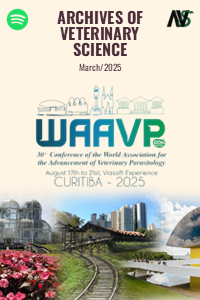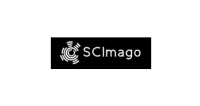Presence of Achatina fulica in the Triple Border – Paraguayan side – a parasitological screening
DOI:
https://doi.org/10.5380/avs.v30i1.96957Keywords:
nematodes, african snail, exotic speciesAbstract
Achatina fulica, (sinom. Lissachatina fulica) or commonly the African Giant Snail (AGS) appears among these exotic species invaders, originating from the East of Africa, and was introduced voluntarily or accidentally in more than 50 countries, which had a negative impact on biodiversity, ecosystems, agriculture and public health. This study aimed to confirm the presence of Achatina fulica in Paraguay and analyze feces, slime and lung tissue in the search of eggs, cysts and larvae of parasites. Fifty specimens were captured in the city of Presidente Franco, Paraguay. The presence of parasites was evaluated using routine parasitology techniques. The average weight was 21.61 grams and 6.26 cm in length. 93% (46/50) of the specimens had parasite eggs, larvae and cysts in fecal samples. No eggs or larvae were found in slime. In the analysis of the lung tissue, eggs and larvae of Strongylid type and Ascaris type was observed. AGS represents a potential threat to the biodiversity of the area and is considered as carrier of parasites. More studies at the molecular level of the larvae recovered are expected to be carried out in the future.
References
ABC Color, 2019. Caracol africano: Especie invasora y dañina - Nacionales [WWW Document]. URL https://www.abc.com.py/nacionales/caracol-africano-especie-invasora-mas-danina-del-mundo-524297.html (accessed 1.18.24).
Albuquerque, F.S., Peso-Aguiar, M.C., Assunção-Albuquerque, M.J.T., Gálvez, L., 2009. Do climate variables and human density affect Achatina fulica (Bowditch) (Gastropoda: Pulmonata) shell length, total weight and condition factor? Brazilian Journal of Biology 69, 879–885. https://doi.org/10.1590/S1519-69842009000400016
Amaya, I., Fajardo, M., Morel, C., Blanco, Y., Devera, R., 2014. Enteroparásitos de interés médico en ejemplares de Achatina fulica capturados en Ciudad Bolívar, estado Bolívar, Venezuela. Vitae: Academia Biomédica Digital, ISSN-e 1317-987X, No. 57 (Enero-Marzo), 2014 3.
Andreazzi, M.A., Gasparotto, F., de Souza Paccola, E.A., da Silva, C.N., Rodrigues, A. de F.C., Lizama, M. de los A.P., 2017. Giant African snail, achatina fulica (Férussac, 1821): An environmental and public health problem in the northwestern of Paraná State, Brazil. Acta Sci Biol Sci 39, 301–307. https://doi.org/10.4025/actascibiolsci.v39i3.35569
Cable, J., Barber, I., Boag, B., Ellison, A.R., Morgan, E., Murray, K., Pascoe, E.L., Sait, S.M., Wilson, A.J., Booth, M., n.d. Global change, parasite transmission and disease control: lessons from ecology. https://doi.org/10.1098/not
Carlson, C.J., Burgio, K.R., Dougherty, E.R., Phillips, A.J., Bueno, V.M., Clements, C.F., Castaldo, G., Dallas, T.A., Cizauskas, C.A., Cumming, G.S., Doña, J., Harris, N.C., Jovani, R., Mironov, S., Muellerklein, O.C., Proctor, H.C., Getz, W.M., 2017. Parasite biodiversity faces extinction and redistribution in a changing climate. Sci Adv 3. https://doi.org/10.1126/SCIADV.1602422
Chen, D., Zhang, Y., Shen, H., Wei, Y., Huang, D., Tan, Q., Lan, X., Li, Q., Chen, Z., Li, Z., Ou, L., Suen, H., Ding, X., Luo, X., Li, X., Zhan, X., 2011. Epidemiological survey of Angiostrongylus cantonensis in the west-central region of Guangdong Province, China. Parasitol Res 109, 305–314. https://doi.org/10.1007/s00436-011-2255-1
Fischer, M.L., Colley, E., 2005. Espécie invasora em reservas naturais: caracterização da população de Achatina fulica Bowdich, 1822 (Mollusca - Achatinidae) na Ilha Rasa, Guaraqueçaba, Paraná, Brasil. Biota Neotrop 5, 127–144. https://doi.org/10.1590/S1676-06032005000100014
Franco-Acuña, D.O., Pinheiro, J., Torres, E.J.L., Lanfredi, R.M., Brandolini, S.V.P.B., 2009. Nematode cysts and larvae found in Achatina fulica Bowdich, 1822. J Invertebr Pathol 100, 106–110. https://doi.org/10.1016/J.JIP.2008.11.008
Gabetti, A., Maganza, A., Prearo, M., Riina, M.V., Nodari, S., Rizzioli, B., Mangini, V., Di Tizio, L., Acutis, P., Dondo, A., Esposito, G., Pastorino, P., 2023. First Report of Giant African Snail (Lissachatina fulica) in a Protected Area of the Cottian Alps, Northwest Italy. Sustainability (Switzerland) 15, 8633. https://doi.org/10.3390/su15118633
García-Livia, K., Reyes, R., Amaro-Ramos, V., Baz-González, E., Martin-Carrillo, N., Rodríguez-Ponce, E., Foronda, P., 2023. Metastrongyloid Infection with Aelurostrongylus abstrusus, Troglostrongylus brevior, Oslerus rostratus and Angiostrongylus chabaudi in Feral Cats from the Canary Islands (Spain). Animals (Basel) 13. https://doi.org/10.3390/ani13132168
Gómez-Camargo, D., Cano-Pérez, E., Torres-Pacheco, J., Barraza-Quiroz, L., Morelos-Muñoz, J., 2021. Population characterization and parasitological assessment of the giant African snail ( Achatina fulica) in urban areas of Cartagena, Colombia. F1000Res 10. https://doi.org/10.12688/F1000RESEARCH.28002.2
Gordon, C.A., McManus, D.P., Jones, M.K., Gray, D.J., Gobert, G.N., 2016. The Increase of Exotic Zoonotic Helminth Infections: The Impact of Urbanization, Climate Change and Globalization. Adv Parasitol 91, 311–397. https://doi.org/10.1016/bs.apar.2015.12.002
Hu, X., Du, J., Tong, C., Wang, S., Liu, J., Li, Y., He, C., 2011. Epidemic status of Angiostrongylus cantonensis in Hainan island, China. Asian Pac J Trop Med 4, 275–277. https://doi.org/10.1016/S1995-7645(11)60085-0
Impacts of Salinity Stress on Plants and Their Tolerance Strategies: A Review, 2022. . Middle East Journal of Applied Sciences. https://doi.org/10.36632/MEJAS/2022.12.3.27
Lopez-Osorio, S., Navarro-Ruiz, J.L., Rave, A., Taubert, A., Hermosilla, C., Chaparro-Gutierrez, J.J., 2021. Aelurostrongylus abstrusus Infections in Domestic Cats (Felis silvestris catus) from Antioquia, Colombia. Pathogens 10. https://doi.org/10.3390/pathogens10030337
Martin, K., Sommer, M., 2004. Relationships between land snail assemblage patterns and soil properties in temperate-humid forest ecosystems. J Biogeogr 31, 531–545. https://doi.org/10.1046/J.1365-2699.2003.01005.X
Morassutti, A.L., Thiengo, S.C., Fernandez, M., Sawanyawisuth, K., Graeff-Teixeira, C., 2014. Eosinophilic meningitis caused by Angiostrongylus cantonensis: An emergent disease in Brazil. Mem Inst Oswaldo Cruz. https://doi.org/10.1590/0074-0276140023
MSPBS, 2019. Caracol gigante africano: conozca las medidas de protección y como identificarlo - Ministerio de Salud Publica y Bienestar Social [WWW Document]. URL https://www.mspbs.gov.py/portal/28794/caracol-gigante-africano-conozca-las-medidas-de-proteccion-y-como-identificarlo.html (accessed 1.18.24).
Muzzio, J., 2011. Moluscos hospederos intermediarios de angiostrongylus cantonensis en dos provincias de ecuador 9, 11–12.
Norte Chaco, 2023. Reaparecen los temidos caracoles africanos en Paraguay [WWW Document]. URL https://www.diarionorte.com/244986-reaparecen-los-temidos-caracoles-africanos-en-paraguay (accessed 1.18.24).
OIRSA, O.I.R. de S., 2020. Analisis de riesgo sobre el Caracol Gigante (Achantina fulica) en la region de OIRSA.
Okon, And Onwuka, H.A., 2017. Comparative morphometric traits differentiation and phenotypic correlations between Achatina achatina (Linne, 1758) and Achatina fulica (Bowdich, 1822) snails with four and five whorls. Journal of Animal Science and Veterinary Medicine 2, 102–108. https://doi.org/10.31248/JASVM2017.048
Onyishi, G.C., Aguzie, I.O., Okoro, J.O., Nwani, C.D., Ezenwaji, N., Oluah, N.S., Okafor, F.C., 2018. Terrestrial Snail Fauna and Associated Helminth Parasites in a Tropical Semi-Urban Zone, Enugu State, Nigeria. Pak J Zool 50, 1079–1085. https://doi.org/10.17582/JOURNAL.PJZ/2018.50.3.1079.1085
Pathak, C.R., Luitel, H., Utaaker, K.S., Khanal, P., 2023. One-health approach on the future application of snails: a focus on snail-transmitted parasitic diseases. Parasitology Research 2023 123:1 123, 1–18. https://doi.org/10.1007/S00436-023-08021-Z
Patiño-Montoya, A., Murillo-García, O., Giraldo, A., 2021. Allometry and geographic variation of the morphology of Achatina fulica (Achatinidae) in Colombia. Molluscan Res 41, 57–63. https://doi.org/10.1080/13235818.2020.1865513
Penagos-Tabares, F., Lange, M.K., Chaparro-Gutiérrez, J.J., Taubert, A., Hermosilla, C., 2018. Angiostrongylus vasorum and Aelurostrongylus abstrusus: Neglected and underestimated parasites in South America. Parasit Vectors. https://doi.org/10.1186/s13071-018-2765-0
Penagos-Tabares, F., Lange, M.K., Vélez, J., Hirzmann, J., Gutiérrez-Arboleda, J., Taubert, A., Hermosilla, C., Chaparro Gutiérrez, J.J., 2019. The invasive giant African snail Lissachatina fulica as natural intermediate host of Aelurostrongylus abstrusus, Angiostrongylus vasorum, Troglostrongylus brevior, and Crenosoma vulpis in Colombia. PLoS Negl Trop Dis 13, e0007277. https://doi.org/10.1371/journal.pntd.0007277
Pozio, E., 2020. How globalization and climate change could affect foodborne parasites. Exp Parasitol. https://doi.org/10.1016/j.exppara.2019.107807
Ramdwar, M., 2018. Farmers’ Experiences with the Giant African Snail Infestation: A Case Study in the Orange Grove Farming District, Trinidad West Indies. Int J Soc Sci Stud 7, 72. https://doi.org/10.11114/IJSSS.V7I1.3972
Raut, S.K., Barker, G.M., 2002. Achatina fulica Bowdich and other Achatinidae as pests in tropical agriculture. . Molluscs as crop pests 55–114. https://doi.org/10.1079/9780851993201.0055
Rose, H., Caminade, C., Bolajoko, M.B., Phelan, P., van Dijk, J., Baylis, M., Williams, D., Morgan, E.R., 2016. Climate-driven changes to the spatio-temporal distribution of the parasitic nematode, Haemonchus contortus, in sheep in Europe. Glob Chang Biol 22, 1271–1285. https://doi.org/10.1111/gcb.13132
Schneider, M.C., Aguilera, X.P., da Silva Junior, J.B., Ault, S.K., Najera, P., Martinez, J., Requejo, R., Nicholls, R.S., Yadon, Z., Silva, J.C., Leanes, L.F., Periago, M.R., 2011. Elimination of neglected diseases in Latin America and the Caribbean: A mapping of selected diseases. PLoS Negl Trop Dis 5. https://doi.org/10.1371/journal.pntd.0000964
Segura, J., Alcala-Canto, Y., Figueroa, A., Del Rio, V., Salgado-Maldonado, G., 2023. A Simple Fecal Flotation Method for Diagnosing Zoonotic Nematodes Under Field and Laboratory Conditions. Journal of Visualized Experiments 2023. https://doi.org/10.3791/66110
Senave, 2018. Advierte sobre peligros que representa el caracol africano [WWW Document]. URL https://www.ip.gov.py/ip/piden-no-manipular-los-caracoles-africanos/ (accessed 1.18.24).
Silva, G.M., Santos, M.B., Melo, C.M., Jeraldo, V.L.S., 2019. Achatina fulica (Gastropoda: Pulmonata): Occurrence, environmental aspects and presence of nematodes in Sergipe, Brazil. Brazilian Journal of Biology 80, 245–254. https://doi.org/10.1590/1519-6984.190291
Sridhar, V., Vinesh, L.S., Jayashankar, M., 2014. Mapping the potential distribution of Achatina fulica ( Bowdich ) ( Stylommatophora : Achatinidae ) in India using CLIMEX , a bioclimatic software. Pest Managenment in Horticultural Ecosystems 20, 14–21.
Taubert, A., Pantchev, N., Vrhovec, M.G., Bauer, C., Hermosilla, C., 2009. Lungworm infections (Angiostrongylus vasorum, Crenosoma vulpis, Aelurostrongylus abstrusus) in dogs and cats in Germany and Denmark in 2003-2007. Vet Parasitol 159, 175–180. https://doi.org/10.1016/j.vetpar.2008.10.005
Traversa, D., Guglielmini, C., 2008. Feline aelurostrongylosis and canine angiostrongylosis: A challenging diagnosis for two emerging verminous pneumonia infections. Vet Parasitol. https://doi.org/10.1016/j.vetpar.2008.07.020
Última Hora, 2023. Tras la crecida aparecen caracoles africanos en B° San Alfredo de CDE [WWW Document]. URL https://www.ultimahora.com/tras-la-crecida-aparecen-caracoles-africanos-en-b-san-alfredo-de-cde (accessed 1.18.24).
Vázquez, A.A., Sánchez, J., 2015. First record of the invasive land snail Achatina (Lissachatina) fulica (Bowdich, 1822) (Gastropoda: Achatinidae), vector of Angiostrongylus cantonensis (Nematoda: Angiostrongylidae), in Havana, Cuba. Molluscan Res 35, 139–142. https://doi.org/10.1080/13235818.2014.977837
Downloads
Published
How to Cite
Issue
Section
License
Copyright (c) 2025 Archives of Veterinary Science

This work is licensed under a Creative Commons Attribution-ShareAlike 4.0 International License.
Authors that wish to publish in AVS agree with the following conditions:
- To keep copyright of the article and allow the AVS to publish the first time. The article will be licensed by Creative Commons - Atribuição 4.0 Internacional allowing the sharing of their work.
- Authors may distribute their work by other channel of distribution (ex.: local or public repository).
- Authors have the permission to publish their work online, using different channels (similar to above), even before the final editorial process.














